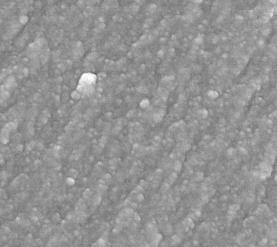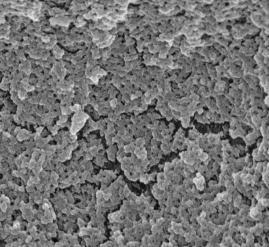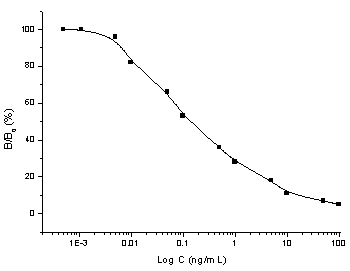Specific molecularly imprinted polymer for identifying chloramphenicol, chemiluminescent kit, detection method and application
A chemiluminescence reagent, molecular imprinting technology, applied in chemiluminescence/bioluminescence, analysis by chemical reaction of materials, material separation, etc., can solve the problem of increasing false positive result ratio, etc., achieve strong tolerance, reduce The effect of wasting resources and reducing inspection costs
- Summary
- Abstract
- Description
- Claims
- Application Information
AI Technical Summary
Problems solved by technology
Method used
Image
Examples
Embodiment 1
[0031] Example 1 Molecularly imprinted polymer synthesis example 1
[0032] (a) Put 1 part of pseudomolecular template nitrobenzene, 3 parts of functional monomer methacrylic acid, 20 parts of initiator azobisisobutyronitrile and 20 parts of crosslinker ethylene glycol dimethacrylate in In chloroform solvent, react at 60°C for 12 hours to obtain solid particles;
[0033] (b) Put the solid particles in a Soxhlet extractor, and continuously reflux with methanol and acetic acid (9:1, V / V) extraction solution for 12 hours to extract the imprinted pseudo-template molecule nitrobenzene;
[0034] (c) drying the reacted solid particles in step (b) to obtain a specific molecularly imprinted polymer of chloramphenicol.
Embodiment 2
[0035] Example 2 Molecularly imprinted polymer synthesis example 2
[0036] (a) Put 1 part of pseudomolecular template nitrobenzene, 6 parts of functional monomer methacrylic acid, 30 parts of initiator azobisisobutyronitrile and 30 parts of crosslinker ethylene glycol dimethacrylate into In chloroform solvent, react at 70°C for 10 hours to obtain solid particles;
[0037] (b) Put the solid particles in a Soxhlet extractor, and continuously reflux the extraction solution of methanol and acetic acid (9:2, V / V) for 24 hours to extract the imprinted pseudo-template molecule nitrobenzene;
[0038] (c) drying the reacted solid particles in step (b) to obtain a specific molecularly imprinted polymer of chloramphenicol.
Embodiment 3
[0039] Example 3 Molecularly imprinted polymer synthesis example 3
[0040] (a) Put 1 part of pseudomolecular template nitrobenzene, 4 parts of functional monomer methacrylic acid, 25 parts of initiator azobisisobutyronitrile and 25 parts of crosslinker ethylene glycol dimethacrylate in In chloroform solvent, react at 65°C for 11 hours to obtain solid particles;
[0041] (b) Put the solid particles in a Soxhlet extractor, and continuously reflux the extraction solution of methanol and acetic acid (9:0.5, V / V) for 18 hours to extract the imprinted pseudo-template molecule nitrobenzene;
[0042] (c) drying the reacted solid particles in step (b) to obtain a specific molecularly imprinted polymer of chloramphenicol.
[0043] The scanning electron micrographs of the molecularly imprinted polymer prepared in this example are as follows: figure 2 shown by figure 2 It can be seen that its surface is porous, which is a cavity formed by template molecular imprinting, which can rec...
PUM
| Property | Measurement | Unit |
|---|---|---|
| Half inhibitory dose | aaaaa | aaaaa |
Abstract
Description
Claims
Application Information
 Login to View More
Login to View More - Generate Ideas
- Intellectual Property
- Life Sciences
- Materials
- Tech Scout
- Unparalleled Data Quality
- Higher Quality Content
- 60% Fewer Hallucinations
Browse by: Latest US Patents, China's latest patents, Technical Efficacy Thesaurus, Application Domain, Technology Topic, Popular Technical Reports.
© 2025 PatSnap. All rights reserved.Legal|Privacy policy|Modern Slavery Act Transparency Statement|Sitemap|About US| Contact US: help@patsnap.com



